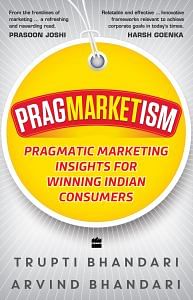American Style Cream & Onion is our biggest success to date.’ ‘Sensodyne is going to change the dental landscape in India.’
But these successful launches sit over the debris of many failures. They involved the same people, the same teams and the same enthusiasm; yet, the results spawned could not have differed any more.
Innovate or perish. This has been our hard-earned learning over the years. There is no choice. It turns out that this is where managers crash into their Waterloo or ascend to Mecca.
Innovation can be summarised as follows: doomed if you do, perish if you don’t. Innovation succeeds in less than 2 per cent of the cases. Dishearteningly, it may take anywhere between 30 to 40 per cent of the brand manager’s time (the rest may be spent on justifying why he doesn’t need innovation); it actually gives very little credit to his stint. Yet, he is likely to be rewarded more for his failure in attempting an innovation than for saving the company’s time and effort by staying away from it. Why do successful companies hanker after innovation so much, when in fact it yields so little?
Innovation has a real benefit and a perceived benefit. If even one in several innovations click, the future of the firm is insured. Not only does the company become futuristic but it also acquires the tenacity and financial muscle to support the growth. The perceived benefit is that brands that constantly innovate stay relevant and contemporary for consumers and customers. Moreover, it imparts dynamism, purpose and consumer orientation within the company, leading to constant growth.
So, the question is not whether or not to innovate, but how to innovate infallibly. Knowing in advance that failure is statistically inevitable, how do you dodge it so that you don’t share the fate of iconic companies like Kodak or Nokia?
Also read: ‘Pragmarketism’ — new book offers insights on how to win the many kinds of desi consumers
Innovation Waterloos
To succeed, the reasons for failure must be made transparent so that recurrence of what’s mentioned below is eliminated.
Boss is the consumer: In a worse scenario, the consumer is the boss’s wife. Surprisingly, we found that innovation is often an attempt to please seniors. Internal feelings often masquerade as consumer insight. A story is often narrated about a boss feeling that the thick deposition of tomato solids around and inside the cap of tomato ketchup bottles was ugly and that research and development (R&D) should find a way to remove it. After intense research, the product was improved and launched, but it met with instant rejection. The reason? Consumers found the deposition to be a sign of naturality. Failure is inevitable when the consumer is kept out of sight.
Lack of differentiation: Old wine in older bottles. Endless flavours, aromas, colours and shapes as extensions of existing brands with fanciful new taglines don’t count as innovation. Line extensions rarely enrich brands because a brand works best if it’s based on a single proposition. Pushing too many ancillary features without any real differentiation dilutes the core equity of the brand without the joy of additional revenue.
Poor presentation: A great product that is clumsily packaged attracts dust instead of consumer intrigue. The concept of a product that precedes the experience must draw the consumer with the right expectation. The Tata Nano car was an engineering marvel at a wonder price of `1 lakh (INR 100,000). But positioning it as the dream of the miserable two-wheeler hopefuls robbed the potential owners of much pride in the eyes of the club of car- owners that they were waiting to join. Unless the concept of the product inspires hope of novelty, consumers simply don’t show up. Often, the graphics and packaging (a ruefully undeveloped industry across all categories in India) discourages rather than entices consumers, leaving many great products untried. For that reason, Paper Boat’s entry with a flexibly contoured bottle, reminiscent of childhood paper boats, moved consumers towards quick trials.
Also read: Gattu, the mischievous Asian Paints mascot who ruled Indian hearts for over 50 years
Insufficient follow-up: The hoopla and hysteria around a new launch product is rarely sustained afterwards. Availability becomes patchy, stocks become old, visibility a nightmare and replenishment and channel selection thoughtless. Consumer perception takes a knock, and any chances to improvise any aspect of the launch (product, placement, promotion and price) is lost sight of. In reality, a lot of uncertain starts can be corrected mid-course to yield infallible results if managers continue to follow up on the response during the initial days. However, often, the management takes a premature call, dismissing a failure or extolling a success too soon after the launch, ignoring opportunities to improvise.
Perfection paralysis: The tendency to dot all I’s and cross all T’s of innovation means waiting too long in the green room even as competitors are stealing the march on you. The idea of first-time- right overplays the importance of fixing everything you know before the launch versus things you don’t know subsequent to the launch. In hypercompetitive fluid times, it’s better to get into the market with 90 per cent readiness on time rather than 100 per cent readiness after the consumer bus has left. Some answers emerge as real action kicks in, while some can be answered with the learnings post the launch, but that can happen only when ‘improvise as you go along’ is the motto along with servicing consumer needs promptly.
Return-of-investment (ROI) anxiety: Corporates love to check ROI against an imagined and unrealistic ideal. New products need time to take root. The cycle of AIDA needs to go round for returns to follow. Yet, we imagine our consumers waiting at the bus stop to better their lives with our deodorant. And if they are not there when we want them to be, investments are reviewed to be cut, diverted or withdrawn, cutting short the basic gestation period of the idea.

This excerpt from Pragmarketism: Pragmatic Marketing Insights For Winning Indian Consumers has been published with special permission from Harper Collins. It will be released on 22 September on SoftCover, ThePrint’s e-venue to launch select non-fiction books.



